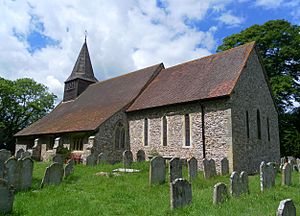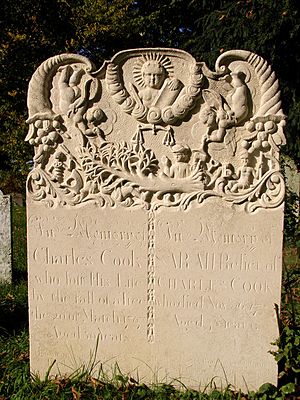St Mary's Church, Walberton facts for kids
Quick facts for kids St Mary's Church |
|
|---|---|

The church from the north
|
|
| 50°50′35″N 0°37′18″W / 50.8430°N 0.6216°W | |
| Location | Church Lane, Walberton, West Sussex BN18 0UD |
| Country | England |
| Denomination | Church of England |
| History | |
| Status | Parish church |
| Founded | 11th century |
| Dedication | Mary, mother of Jesus |
| Architecture | |
| Functional status | Active |
| Heritage designation | Grade I |
| Designated | 5 June 1958 |
| Style | Late Saxon/Norman |
| Administration | |
| Parish | Walberton |
| Deanery | Rural Deanery of Arundel and Bognor |
| Archdeaconry | Chichester |
| Diocese | Chichester |
| Province | Canterbury |
St Mary's Church is an Anglican church located in the village of Walberton. This village is in West Sussex, England. The church is very old, dating back to the 11th century.
Over the years, the church has been repaired and changed many times. Some parts of the original Saxon building are still visible. You can even see old Roman building materials reused in its walls! The churchyard has many old gravestones from the 1700s. St Mary's Church is a very important historical building. It is protected as a Grade I Listed building.
Contents
The Church's Long History
The village of Walberton is near Arundel and Chichester. It grew up close to old Roman roads. A church was first mentioned here in the Domesday Book in 1086. This book was a big survey of England ordered by William the Conqueror. Having a priest at that time showed the church was important.
The first church was a simple building. It had a main room called a nave and a smaller area called a chancel. The west wall of the nave was built with stones from nearby Roman sites. In 1105, the church was given to an abbey in France. Later, a priory (a type of monastery) in Boxgrove took control of it. This lasted until the 1500s.
Changes Over the Centuries
The church changed a lot in the 1100s. New sections, called aisles, were added to the nave. These aisles were built over a long time. This is why their columns and arches are all different sizes. In the 1200s, the chancel was rebuilt and made wider. Lancet windows, which are tall, narrow windows, were added. A rare north porch was also built then.
In the 1300s, the arch between the nave and chancel was replaced. A new roof was put on the nave in the 1400s. This roof covered the nave and aisles in one smooth line. New windows were also added around this time.
Repairs and Restorations
The church needed many repairs in the 1600s and 1700s. The roof and the south aisle had to be fixed. In the 1800s, more changes were made. The porch, chancel, and belfry were altered. The old Saxon entrance door was even blocked up.
By the early 1900s, the church needed a huge repair. The nave was in danger of falling down! People donated money to fix it. An architect named Richard Creed led the work. His changes were very big. They removed almost all of the church's very old parts. New supports were added to the walls. The belfry got a new structure, and the roofs were fixed again.
Interesting Gravestones in the Churchyard
The churchyard is large and has many old gravestones. Some are made of wood, which is rare. Gravestones from the 1700s often had scary carvings. At Walberton, three gravestones show how people died. The most famous one is for Charles Cook, who died in 1767.
His white gravestone shows him crushed under a fallen tree. A laughing skeleton, a man with an axe, and Father Time are watching. Above them, angels play trumpets. These pictures were important because many people could not read back then.
Another famous person buried here is Frederick Marquis, 1st Earl of Woolton. He was the Minister of Food during World War II. The wartime dish, Woolton pie, was named after him. He used to live in Walberton House.
In 1834, a large stone coffin was found near the church. It might be from the Saxon period. Today, you can see it inside the church. A lychgate was added at the churchyard entrance in the 1900s.
Church Design and Features
St Mary's Church is mostly built from flint stones. It also has some smooth ashlar stones and bricks. The church has a chancel, a nave with aisles, a porch, and a tiled roof. A shingled spire sits on top of the weatherboarded belfry. Part of the nave is now used as a vestry and other rooms.
The entrance door at the west end is the only place where you can still see very old, pre-Norman stonework. The chancel still has its original 13th-century lancet windows. Other windows in the church were changed in the 1400s and many have been replaced since. The windows in the north porch have special three-leaf shapes at the top.
The belfry and its wooden frame are typical for this area. It holds six bells. Three of these bells were added in 1903. The other bells are much older, from the 1500s and 1700s, but they were remade during the big restoration. Inside the church, you can see the Saxon stone coffin under the west window. There is also an old stone font that was found in a field.
The Church Today
St Mary's Church was officially named a Grade I Listed building on June 5, 1958. This means it is a very important historical building.
The church serves the modern parish of Walberton. This area includes Walberton village and smaller places like Fontwell and Avisford. Since 1929, St Mary's Church has worked together with St Mary's Church in nearby Binsted. They share a vicar and resources.
See also
- Grade I listed buildings in West Sussex
- List of places of worship in Arun


